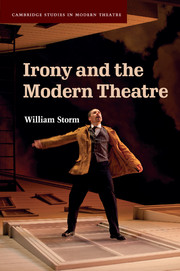Book contents
- Frontmatter
- Contents
- Acknowledgements
- Introduction
- 1 Irony personified: Ibsen and The Master Builder
- 2 The character of irony in Chekhov
- 3 Irony and dialectic: Shaw's Candida
- 4 Pirandello's “Father” – and Brecht's “Mother”
- 5 Absurdist irony: Ionesco's “anti-play”
- 6 “Ironist First Class”: Stoppard's Arcadia
- 7 American ironies: Wasserstein and Kushner
- 8 Irony's theatre
- Notes
- Works cited
- Index
5 - Absurdist irony: Ionesco's “anti-play”
Published online by Cambridge University Press: 01 June 2011
- Frontmatter
- Contents
- Acknowledgements
- Introduction
- 1 Irony personified: Ibsen and The Master Builder
- 2 The character of irony in Chekhov
- 3 Irony and dialectic: Shaw's Candida
- 4 Pirandello's “Father” – and Brecht's “Mother”
- 5 Absurdist irony: Ionesco's “anti-play”
- 6 “Ironist First Class”: Stoppard's Arcadia
- 7 American ironies: Wasserstein and Kushner
- 8 Irony's theatre
- Notes
- Works cited
- Index
Summary
The glorious illogic of Eugene Ionesco's The Bald Soprano, and the causal disruptions that characterize the playwright's vision more generally, have a basis in extreme contradiction, and that contradictory principle is, in turn, situated fundamentally in irony. Indeed, the play's subtitle, “Anti-play,” can be understood as referring to an intrinsic pattern of opposition that affects character qualities and behaviors (Mr. and Mrs. Smith and Mr. and Mrs. Martin, most notably), whimsical matchings of cause and effect in relation to time, location, and event, and the fundamentals of dramaturgical structure. For Ionesco, in fact, such opposition is not so much an effect of the dramatic proceedings as it is an underlying precept for the sensibility as well as the disharmonious action of The Bald Soprano. In this sense primarily, a pervasive antagonism in Ionesco's theatre can be distinguished from more typical understandings of conflict and also from the ironic aspect of dialectic as examined here in association with Bernard Shaw and Luigi Pirandello in particular. Just as the Pirandellian theatre is marked by a sentimento del contraria (the “feeling of the opposite” that becomes progressively more inclusive in accord with its own tendencies toward the negative), Ionesco's vision is characterized typically by perpetually negating correlations, as words and ideas elicit, and tend often to cancel out, their referential partners. In the context of this inclination, Rosette Lamont identifies a pervasive “anti-attitude” in Ionesco's drama and associates this with the playwright's “all-embracing irony” (Imperatives 5).
- Type
- Chapter
- Information
- Irony and the Modern Theatre , pp. 132 - 152Publisher: Cambridge University PressPrint publication year: 2011



